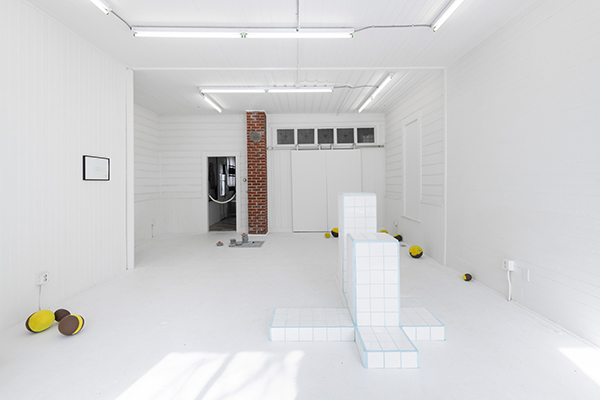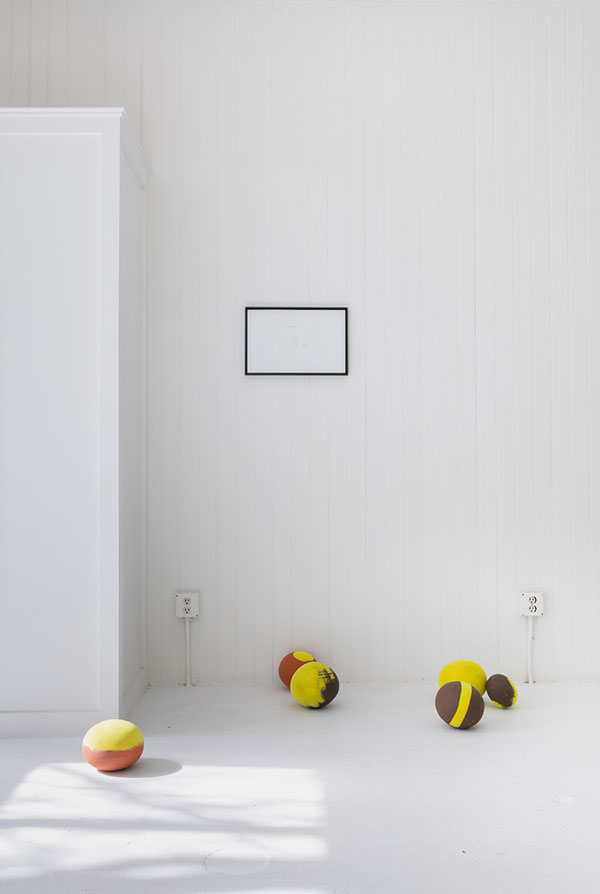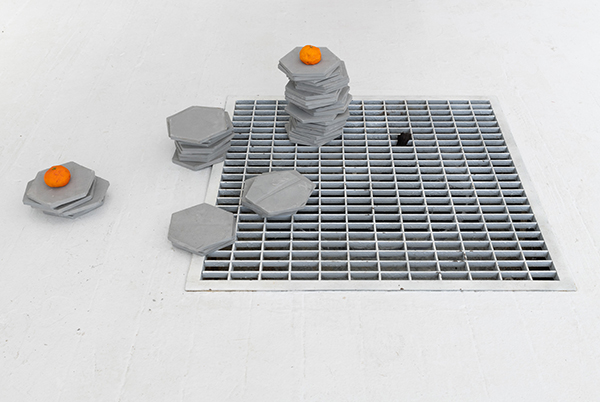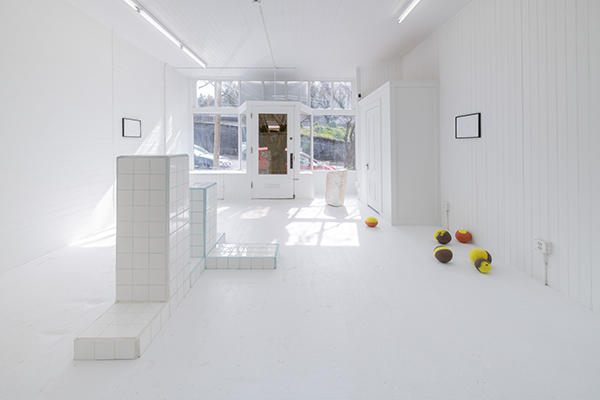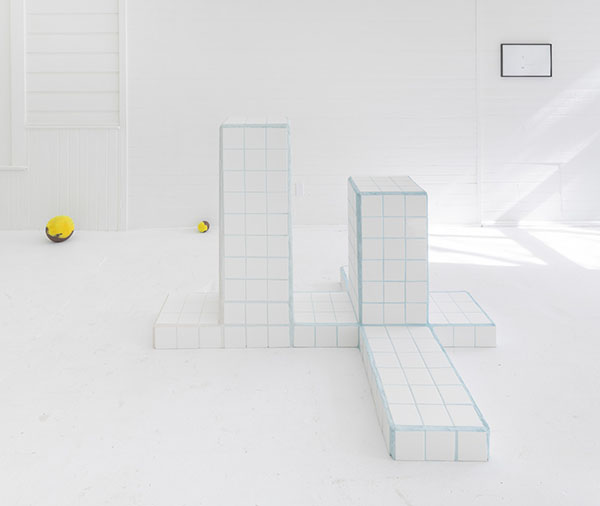AND NOW, SQUARE TREES
sidony o’neal
March 3 - April 27, 2019
@
Fourteen30 Contemporary
by Lisa Radon
Almost imperceptibly inscribed on the dark steel of the haggard looking hand forged knife blade is the title of the exhibition. The blade, speckled with rust, is stabbed into a pillar of styrofoam that appears to have lived other lives the way a buoy that washes up after a storm reports its journey through its roughened surface and ocean-sun-salt patina. The blade, notably, is handleless. The work is untitled. Or rather titled, Untitled.
The moment you see the hip-high pillars and low platforms of sidony o’neal’s sculpture, FOR I WAS AN EDIBLE YOUTHFUL LIFEFORM WITH DREAMS OF BECOMING GRITS—trunk and exposed roots perhaps—tiled in white squares with pale blue grout referencing the pixel-cube construction of Minecraft objects as well as the graph paper favored by D&D Dungeon Masters, you know we are having an experience in gamespace, oscillating somewhere between the digital and the analog. The game map aesthetic is nodded to as well in O’Neal’s untitled graphite drawings on graphed vellum that are at once writing, diagram, and tracing of o’neal’s ongoing practice (a bright yellow conté form in one drawing references the hue she’s worn in a handful of performances). And here in the realized imaginary, trees are indeed square and in no need of the light of the sun, minerals from the soil, rain. Here, they also need not participate in photosynthesis or the production of oxygen. Here in an alternate world beyond worlds, where the rules are emphatically not those of the natural world, there is both space outside of imminent environmental threat as well as space for thinking futures otherwise. The player/user/artist/viewer is freed for a moment from the politico-socio-enviro exigencies of the real world save contending with the way the energy was generated to power the sick gaming PC or the environmental costs of the production of a 20-sided plastic die. If you want to get a handle on gamespace, Sharp One, you are going to have to make it yourself, work in and around the rules to get some leverage. Or get a handle *in* gamespace, name yourself; this is another requirement of this space. Vernor Vinge’s important 1981 short story “True Names” offers an early vision of cyberspace as simulated world constructed in part by hackers and populated by their avatars where everyone is known only by their flavorful handle, and one’s true name is one’s ultimate vulnerability.
Names. Words.
On her 30th birthday, o’neal walked into Niña Oscura, a bookstore in Mexico City named, o’neal says, after a little girl who wandered into the shop on the first day it was open. The owner told o’neal, “No one ever saw the little girl leave.” In Niña Oscura, O’Neal came upon an English language issue of New Age magazine. On the back of the works list for the exhibition, there is a list-like poem of distinct, standalone lines, one of which is the name of the exhibition. “World Game Now:,” the second line reads, “How to Make Our World Work” followed by “How to make and live in your own space.” With notes about technology and machines among oddball lines like “LAWYERS SUSPECT LAWYERS,” the poem eventually heads into lines on death and dying, reinforcing the shadow cast by the square tree of FOR I WAS as comment on the future fate of the very real trees outside the window of the gallery. o’neal tells me that the lines of the poem list every article title in the table of contents in that found issue of New Age.
CUTTY.
Enter with this word hanging over your head on a vinyl banner hung above the door outside this storefront gallery next to a freeway in Portland, Oregon. Sketchy is one definition of this slang word. As multivalent as slang often is, o’neal notes in conversation that cutty also points to cuz, cousin, familiar if not family. Come in. In her talk at the end of the exhibition, o’neal refers to the knife as her “cutty buddy.”
The sign, the banner, while marking this space, takes it and the works therein out of the easy digestibility viewers can be accustomed to in a generic white walled commercial art space, sets it apart as something else or simply functions as an ALERT. Also, as often is the case in O’Neal’s works, it asks one to slow down, demands a bit more, rewards a sustained engagement. It points, as the artist says, to other than itself, “vectoring outward.” It also functions as a puncture point in the white cubed space of the exhibition to let the world leak in.
On the white floor throughout the space, dark grey ceramic spheres, head-scale, are scattered around, their rough surfaces interrupted by swaths and swirls of yellow flocking. o’neal thinks of the flocked spheres as "child objects.” Not childlike, not *for* children, not children per se, but a child class of objects the way one would write a child class when coding in CSS. Nested. It is not incidental that table top gamers lovingly flock the boxes that hold their die.
Occulted from initial view, around a corner, o’neal installed meet cute 3: super farmacia, a black bathroom sink that is faucetless, (handle-less), offering no water or mechanism for attaining it, but is somehow “filled” with something designated (pointed to) by this dark mirrored acrylic waterline. The sum of this reflective surface combined with the absence of plumbing (or the usual ins and outs expected in a sink object) suggest there are other entrances or openings referenced here. I read it as a portal. Some sentences back, I fought autocorrect wanting to translate “cutty” to “cute.” Whom does one meet in a mirror? On the underside of the sink, and reflected in a mirror on the floor beneath are the words super farmacia de dios, super pharmacy of god. The gallery attendant tells me this is a shop sign the artist saw in Mexico City. On that mirror is a piece of rubber-coated obsidian, a stone for self-reflection indeed but also protection…the kind of protection that one might require when opening a portal perhaps or the kind of protection with which one might want to cloak one’s gamespace. Perhaps not incidentally, obsidianportal.com is a website that supports DMs managing RPG tabletop games. If a meet cute is a beginning, it’s fair to speculate that O’Neal associates this beginning with perhaps their and definitely the viewer’s own reflection.
Even if you’re not playing, I’m gassed to see you in the world. In this work again o’neal addresses points of entry and exit in the gamespace of this exhibition while also acknowledging the stakes…what’s at risk, what’s at stake in this round of the game…who has made a risky move, who has played it safe, and who has opted out of the gameplay. On a floor ventilation grate, o’neal stacks unfired ceramic hexagon markers in all of their albeit materially fragile potential for marking space, accounting for value. They are stacked with a couple of small orange citrus fruits and a length of silk hung down into the space below the grate. I feel like she’s marking out space, welcoming or maybe tolerating n00bs like me into a world we barely understand.
Let’s think about gamespace for a moment. Let’s think about the procedurally generated. Let’s think about the lay of the land, the rules, the assigned roles of the players, parameters of possible actions, embedded rewards guiding play choices. What are the demographics of the writers of the rules of the majority of games played (both digital and analog)? What can we extrapolate from thinking about the making and playing of games to apply to our considerations of the way those with power have and continue to structure the game called life. Not unrelated is real alarm about who’s collecting and selecting the data sets that we are feeding to AI’s to teach them about the world. To narrow the focus slightly, questions around parameters and conditions are quite apposite in a commercial gallery setting as a window on the economies and circulation of art. To flip it around, in gamespace, in this Temporary Autonomous Zone, can we set the terms of engagement otherwise, have the option to enter into the contract of participation with a clear sense of roles, protocols, and potential, and prototype other economies, situations, relations, modes of being, and methods of circulation.


